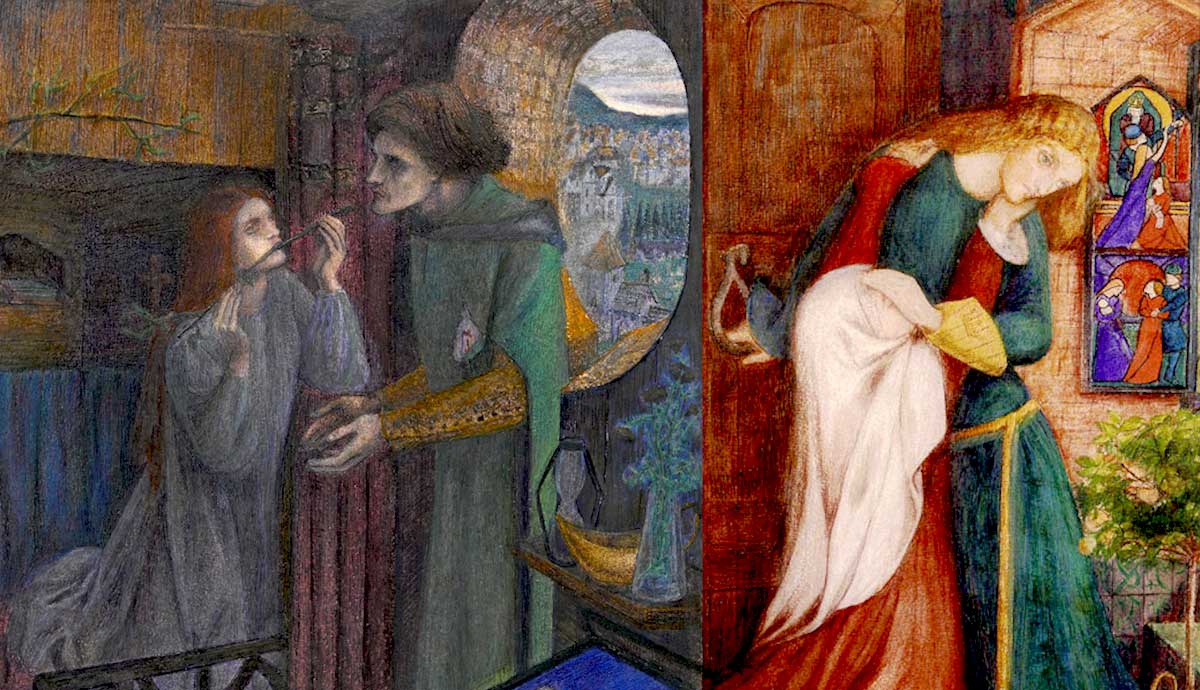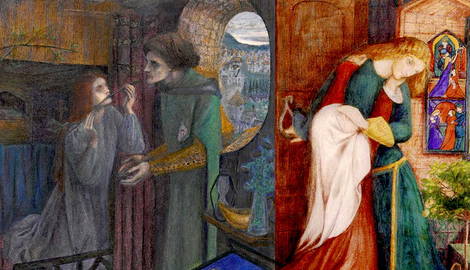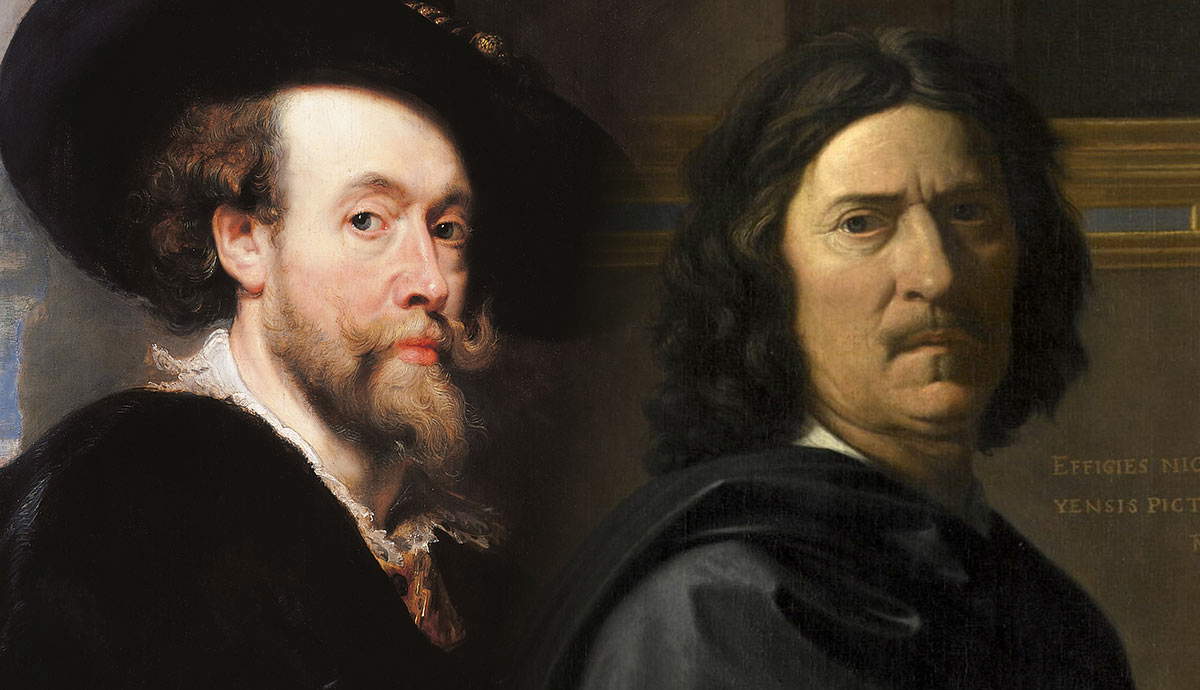
After its inception in Victorian-era London, the Pre-Raphaelite Brotherhood was immortalized by the strikingly avant-garde art of its most successful male contributors, including Dante Gabriel Rossetti, William Holman Hunt, and John Everett Millais. The creative contributions of women to the so-called brotherhood were overshadowed—but they were significant. Elizabeth Siddal was among these oft-forgotten, yet profoundly influential, female Pre-Raphaelite figures. Through seven watercolors and drawings, explore how Siddal contributed to the movement as a professional model, an unconventional muse, and an innovative artist in her own right.
1. Elizabeth Siddal: Self–Portrait

From the moment he first met her, the Pre-Raphaelite powerhouse Dante Gabriel Rossetti was obsessed with Elizabeth Siddal, whom he nicknamed Lizzie. As his longtime muse and eventual wife, Siddal helped inspire the signature sensual portrait style—and ultra-stylized feminine features—that made Rossetti famous. Much like a gilded frame or a background textile motif, Rossetti utilized Siddal’s unusual angular facial features and red hair as decorative objects in his compositions—and to subvert traditional notions of idealized feminine beauty in Western art. In John Everett Millais’ Ophelia—a modeling job that made her a local celebrity—Siddal was transformed into a Shakespearean damsel in distress, a timeless and tragic symbol more than an individual person.
Elizabeth Siddal’s own self-portrait, on the other hand, tells a different story about its subject. A small and starkly simple composition, this portrait sheds the exaggerated, decorative facial features and dramatic themes of a Rossetti portrait. Instead of passively gazing off to the side, Siddal paints herself engaged in eye contact with the viewer. The current whereabouts of this painting are unfortunately unknown, and while existing reproductions are not high-quality, it nevertheless provides interesting insight into Siddal’s artistic mind. While other artists saw her as a decorative element, she saw herself foremost as a person and an artist.
2. The Haunted Wood by Elizabeth Siddal

It wasn’t long after picking up a pencil that Elizabeth Siddal found tangible success as an artist. Like other followers of the Pre-Raphaelite movement, Siddal gravitated towards medieval aesthetics and themes, including Arthurian legends and the poetry of Alfred Lord Tennyson. She studied examples of medieval manuscripts and early Italian Renaissance art as she developed a personalized approach to art that was uniquely expressive and, much to the jealousy of her traditionally-trained peers, distinctly unacademic.
The Haunted Wood, a gouache on paper work from 1856, demonstrates Siddal’s intimate understanding of the aforementioned influences, both visually and thematically. The composition is flat, echoing the composition of medieval illuminations. The awkward, angular limbs of the human figures parallel the tree branches. The subject, which likely draws its narrative from Siddal’s own poetry, is a woman in a dark wood who reaches towards a spectral double of herself. The ethereal strokes of color and form emphasize the figures’ enigmatic, haunting presence. This was the type of “naive” aesthetic that other artists of the time were painstakingly aiming to cultivate in themselves as an avant-garde reaction against their academic training.
3. Lovers Listening to Music

When Elizabeth Siddal was introduced to the art critic John Ruskin, he took a look at her growing portfolio of drawings and declared that she was a better artist than Dante Gabriel Rossetti. Siddal earned the prestigious patronage of Ruskin, who provided her an annual salary in exchange for ownership of the art she produced—including hundreds of sketches, drawings, and watercolors, as well as a single finished oil painting.
One of these works, a drawing called Lovers Listening to Music, was inspired by Ruskin’s advice to Siddal to practice drawing more down-to-earth subjects in the Pre-Raphaelite realism style he so admired. With its stiff anatomical features, strong outline work, medieval-inspired drapery, and skewed perspective, Lovers Listening to Music indeed echoes the work of her fellow early Pre-Raphaelites. But where Siddal gleaned the characters and subject matter of this drawing remains a mystery—it is likely a narrative of her own invention.
4. Clerk Saunders

Elizabeth Siddal’s artistic career only lasted just short of a decade. During this time, she managed to create hundreds of original artworks and grow her reputation as a serious artist among the Victorian-era avant-garde. By 1857, Siddal earned her place as the sole woman artist to exhibit work at the Pre-Raphaelite Exhibition in London—an alternative to the restrictive Royal Academy summer exhibition, and the Pre-Raphelite Brotherhood’s first official group exhibition.
A London newspaper review of the exhibition mentioned Siddal by name: “Her drawings display an admiring adoption of all the most startling peculiarities of Mr. Rossetti’s style, but they have nevertheless qualities which entitle them to high praise.” The reviewer also expressed admiration for the “high, pure, and independent feeling” of Siddal’s rendering of human faces in her drawings.
Clerk Saunders, which was purchased by an American collector in attendance, is a watercolor and chalk drawing of a scene from an old Scottish ballad, wherein the heroine Margaret is visited by her deceased lover, Clerk Saunders. The ghost of Saunders has just entered Margaret’s room, passing through the wall to express his love to her. The stylization of both figures heightens their paleness and angularity, blurring the boundary between the living and the dead. The deliberately flattened and enclosed composition, medieval motifs, chivalric literary reference, and jewel-like colors are all hallmarks of Pre-Raphaelitism, demonstrating Elizabeth Siddal’s keen understanding of—and aesthetic contributions to—the burgeoning movement.
5. Lady Clare

Like Clerk Saunders, Elizabeth Siddal’s watercolor drawing Lady Clare features an arrangement of flattened, jewel-toned color planes echoing medieval stained glass and cloisonné decor. And, like many Pre-Raphaelite works, this drawing was inspired by the narrative poetry of Alfred Lord Tennyson. Siddal depicts a scene where the titular Lady Clare agonizes over whether to tell her betrothed a life-changing secret she has just learned. Her nurse Alice begs her not to reveal the truth, while Lady Clare stares off into space, unsettlingly stoic. While the two figures’ faces reveal little, their contorted bodies express their desperation.
Much like her husband Dante Gabriel Rossetti, Siddal used the female form as a vehicle for dramatic emotional expression instead of accurate anatomical representation. But their creative collaboration was certainly not one-sided. Without any education or experience in the arts, Elizabeth Siddal naturally relied on Rossetti for guidance. But she soon began to see herself as an artist in her own right, and Rossetti was inspired by her creativity, too, as he worked towards unlearning academic conventions in favor of the naive medieval aesthetics and stylized feminine beauty for which he became famous.
6. The Lady of Shalott, by Elizabeth Siddal

What began as an exciting romantic relationship and fruitful artistic collaboration with Dante Gabriel Rossetti eventually led to an unhappy marriage for Elizabeth Siddal. Having suffered from physical illnesses throughout her life, Siddal’s health only deteriorated further after her wedding to Rossetti. Within their first year of marriage, Siddal faced a heartbreaking stillbirth and rumors of her husband’s affairs with other women. To cope with the physical and emotional toll of her newlywed life, Siddal became addicted to laudanum, an opiate that was originally prescribed to ease her chronic pain.
It is not surprising, then, that Siddal would have resonated with the tragic tale of the Lady of Shalott. Based on the Tennyson poem of the same name, the Lady of Shalott was depicted by several Pre-Raphaelite artists, including John William Waterhouse, whose version of the story remains famous today. Siddal’s drawing, however, was one of the first representations of this subject. Imprisoned inside “four gray walls, and four gray towers,” the Lady of Shalott is cursed to remain indoors and observe the outside world only through a mirror.
She spends her days weaving a tapestry, depicting the scenes she sees reflected back to her. When Sir Lancelot rides by, the Lady finally dares to look out the window—an action that leads to her doom. The Lady of Shalott was Elizabeth Siddal’s first signed work, indicating an important turning point at which she began to see herself as a true artist.
7. St. Agnes by Elizabeth Siddal

Tragically, Elizabeth Siddal’s career was cut short when she died at age 32 after overdosing on laudanum. After learning the tragic news, Siddal’s sister-in-law, the renowned poet Christina Rossetti, hung her favorite watercolor drawing by Siddal, St. Agnes, in her home. Characteristically inspired by the poetry of Tennyson, this image depicts the Christian feast day of St. Agnes, the patron saint of chastity. The woman in the painting is a nun in training who, having refused to marry, is contemplating her vows to the church. Cloistered in the foreground, she longingly awaits the chance to see Jesus Christ, whom she considers her bridegroom. Down to the weather, the moment Siddal chose to depict is directly inspired by a verse in Tennyson’s St. Agnes Eve:
“Make Thou my spirit pure and clear
As are the frosty skies,
For me the Heavenly Bridegroom waits,
To make me pure of sin.”

Beyond her Pre-Raphaelite fascination with Tennyson’s poetry, this subject likely resonated with Siddal due to its parallels with the strictly separate gender roles of the Victorian era. True to the oppressive ideology of “separate spheres” for men and women in the Victorian era, the nun in St. Agnes is confined to the feminine sphere—which is private and passive. From inside, she looks out into the masculine sphere—which is public and active. As an artist’s model and then commercially successful artist, Elizabeth Siddal certainly defied the prescribed gender roles of her time. Yet, trapped in an unhealthy marriage and suffering from her lack of success at bearing children, Siddal also felt the negative effects of these rules on women.
Despite the oppression and hardships, she faced throughout her tragically short life, Elizabeth Siddal’s profound presence within the Pre-Raphaelite movement is being increasingly recognized by historians. Fortunately, her contributions are immortalized—not just in the work of her male counterparts, but in her vast, and largely well-preserved, oeuvre of sketches, drawings, and watercolor paintings that demonstrate her uniqueness and influence as an artist.










